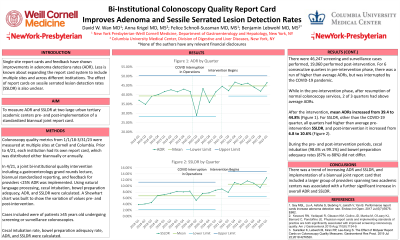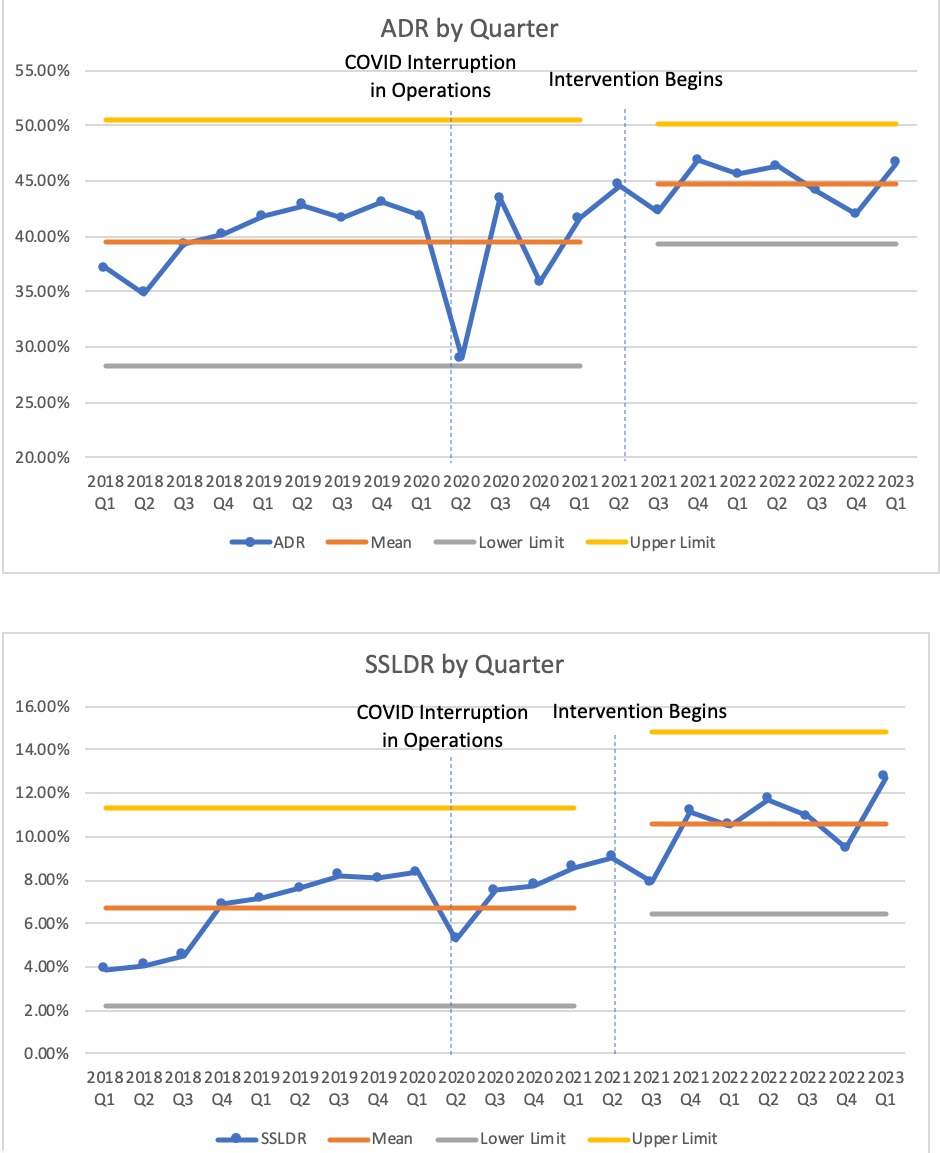Tuesday Poster Session
Category: Colorectal Cancer Prevention
P3178 - Bi-Institutional Colonoscopy Quality Report Card Improves Adenoma and Sessile Serrated Lesion Detection Rates
Tuesday, October 24, 2023
10:30 AM - 4:00 PM PT
Location: Exhibit Hall

Has Audio

David Wan, BS, MD
Weill Cornell Medicine
New York, NY
Presenting Author(s)
David Wan, BS, MD1, Anna Krigel, MD2, Felice Schnoll-Sussman, MD, MS1, Benjamin Lebwohl, MD, MS2
1Weill Cornell Medicine, New York, NY; 2New York-Presbyterian Columbia, New York, NY
Introduction: Single site report cards and feedback have shown improvements in adenoma detections rates (ADRs). Less is known about expanding the report card system to include multiple sites and across different institutions. The effect of report cards on sessile serrated lesion detection rates is also unclear. The aim of this study was to measure ADR and SSLDR at two large urban tertiary academic centers pre- and post-implementation of a standardized biannual joint report card.
Methods: Colonoscopy quality metrics from 1/1/18-3/31/23 were measured at multiple sites at Cornell and Columbia. Prior to April 2021, each institution had its own report card, which was distributed either biannually or annually. In April 2021, a joint bi-institutional quality intervention including a gastroenterology grand rounds lecture, biannual standardized reporting, and feedback for providers < 25% ADR was implemented. Using natural language processing, cecal intubation, bowel preparation adequacy, ADR, and SSLDR were calculated. A Shewhart chart was built to show the variation of values pre- and post-intervention.
Results: There were 46,247 screening and surveillance cases performed, 19,060 performed post-intervention. For the six consecutive quarters in pre-intervention phase, there was run of higher than average ADRs, but was interrupted by the COVID-19 pandemic, when colonoscopy volume significantly declined and led to a more than 3-sigma decrease in ADR. While still in the pre-intervention phase, after resumption of normal colonoscopy services, two of three quarters had above average ADRs. After the intervention, mean ADRs increased by 5.4% (Figure 1a). For SSLDR, other than the COVID-19 quarter, all quarters had higher than average pre-intervention SSLDR, and post-intervention there was a more significant rise of 3.9% (Figure 1b). During the pre- and post-intervention periods, cecal intubation (98.6% vs 99.1%) and bowel preparation rates (87% vs 88%) did not differ significantly.
Discussion: There was a trend of increasing ADR and SSLDR, and implementation of a biannual joint report card that included a larger group of providers spanning two academic centers was associated with a further significant increase in overall ADR and SSLDR.

Disclosures:
David Wan, BS, MD1, Anna Krigel, MD2, Felice Schnoll-Sussman, MD, MS1, Benjamin Lebwohl, MD, MS2. P3178 - Bi-Institutional Colonoscopy Quality Report Card Improves Adenoma and Sessile Serrated Lesion Detection Rates, ACG 2023 Annual Scientific Meeting Abstracts. Vancouver, BC, Canada: American College of Gastroenterology.
1Weill Cornell Medicine, New York, NY; 2New York-Presbyterian Columbia, New York, NY
Introduction: Single site report cards and feedback have shown improvements in adenoma detections rates (ADRs). Less is known about expanding the report card system to include multiple sites and across different institutions. The effect of report cards on sessile serrated lesion detection rates is also unclear. The aim of this study was to measure ADR and SSLDR at two large urban tertiary academic centers pre- and post-implementation of a standardized biannual joint report card.
Methods: Colonoscopy quality metrics from 1/1/18-3/31/23 were measured at multiple sites at Cornell and Columbia. Prior to April 2021, each institution had its own report card, which was distributed either biannually or annually. In April 2021, a joint bi-institutional quality intervention including a gastroenterology grand rounds lecture, biannual standardized reporting, and feedback for providers < 25% ADR was implemented. Using natural language processing, cecal intubation, bowel preparation adequacy, ADR, and SSLDR were calculated. A Shewhart chart was built to show the variation of values pre- and post-intervention.
Results: There were 46,247 screening and surveillance cases performed, 19,060 performed post-intervention. For the six consecutive quarters in pre-intervention phase, there was run of higher than average ADRs, but was interrupted by the COVID-19 pandemic, when colonoscopy volume significantly declined and led to a more than 3-sigma decrease in ADR. While still in the pre-intervention phase, after resumption of normal colonoscopy services, two of three quarters had above average ADRs. After the intervention, mean ADRs increased by 5.4% (Figure 1a). For SSLDR, other than the COVID-19 quarter, all quarters had higher than average pre-intervention SSLDR, and post-intervention there was a more significant rise of 3.9% (Figure 1b). During the pre- and post-intervention periods, cecal intubation (98.6% vs 99.1%) and bowel preparation rates (87% vs 88%) did not differ significantly.
Discussion: There was a trend of increasing ADR and SSLDR, and implementation of a biannual joint report card that included a larger group of providers spanning two academic centers was associated with a further significant increase in overall ADR and SSLDR.

Figure: Figure 1a (top): ADR by Quarter.
Figure 1b (bottom): SSLDR by Quarter.
Figure 1b (bottom): SSLDR by Quarter.
Disclosures:
David Wan indicated no relevant financial relationships.
Anna Krigel indicated no relevant financial relationships.
Felice Schnoll-Sussman indicated no relevant financial relationships.
Benjamin Lebwohl indicated no relevant financial relationships.
David Wan, BS, MD1, Anna Krigel, MD2, Felice Schnoll-Sussman, MD, MS1, Benjamin Lebwohl, MD, MS2. P3178 - Bi-Institutional Colonoscopy Quality Report Card Improves Adenoma and Sessile Serrated Lesion Detection Rates, ACG 2023 Annual Scientific Meeting Abstracts. Vancouver, BC, Canada: American College of Gastroenterology.
